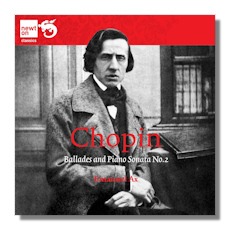
The Internet's Premier Classical Music Source
Related Links
- Chopin Reviews
- Latest Reviews
- More Reviews
-
By Composer
-
Collections
DVD & Blu-ray
Books
Concert Reviews
Articles/Interviews
Software
Audio
Search Amazon
Recommended Links
Site News
 CD Review
CD Review
Frédéric François Chopin

Piano Works
- Four Ballades:
- No. 1 in G minor, Op. 23
- No. 2 in F Major, Op. 38
- No. 3 in A Flat Major, Op. 47
- No. 4 in F minor, Op. 52
- Sonata #2 in B Flat minor, Op. 35
Emanuel Ax, piano
Newton Classics 8802189 61min
There's no doubt about it – Emanuel Ax plays these Chopin works with incredible sensitivity and intelligence. His Ballades can stand with the best from the competition, which includes such stalwarts as Ashkenazy, Glemser, Kissin, and Lise de la Salle. Ax's First Ballade is brilliantly atmospheric in its contrasts: he imparts an appropriately forlorn and agitated character to the main theme and a lovely, songful quality to the alternate theme. The Second Ballade is a bit gentler of course, and Ax gives the work its due while finding plenty of energy, even menace, in the faster music, especially in the closing pages of the work. The Third is the brightest and most optimistic of the four Ballades, and in Ax's hands there's plenty of sunshine here but also a few threatening clouds in the middle section. The Fourth Ballade, the longest and arguably the most complex of the four works, is plumbed for all its expressive depth by Ax, its conflicts and sense of yearning revealed with insight and great feeling, all filtered through Ax's deftly employed wide range of dynamics and all-encompassing technique.
In the Second Sonata Ax is also quite effective, though here the sense of agitation in the first movement main theme is a bit restrained. Still, the overall performance is strong: the second movement is filled with tension and anxiety; the ensuing funeral march is dark and vehement, not nearly as dignified as heard in tamer renditions; and the brief finale – one of Chopin's greatest creations, in my opinion – is eerie and ominous, the pianist wisely not giving in to the tendency to rush or blur the notes. While there are excellent versions of this sonata by Argerich, Cliburn, Rubinstein and scores of others, this one by Ax is certainly competitive with the very best of them.
The recordings were made in 1985 and the sound is quite good for that time, but I have one cavil: there is some kind of breathy or mechanical noise noticeable throughout. Is it the motion of the pedal or some kind of rattle associated with striking the keys? I strongly doubt its source is Ax himself, vocalizing or breathing heavily. It is most noticeable in faster and louder sections, but whatever it is, it's not a major distraction, at least not most of the time. Another oddity about this recording is the very brief pauses between the various pieces, almost as if they are all part of the same work. All in all, this is a fine recital of Chopin works that most admirers of the composer should have in their collection.
Copyright © 2013, Robert Cummings




















